ISSN ONLINE(2319-8753)PRINT(2347-6710)
ISSN ONLINE(2319-8753)PRINT(2347-6710)
Nesibe Gozde Ozerkan1, Omar Liqaa Maki2, Momen Wael Anayeh3, Stian Tangen4, Aboubakr M. Abdullah5,6
|
| Related article at Pubmed, Scholar Google |
Visit for more related articles at International Journal of Innovative Research in Science, Engineering and Technology
It is the objective of this project is to investigate the mechanical and chemical behaviour of new concrete type obtained by adding aluminium dross which is an impure aluminium mixture that results from metals melting and mixing with flux. The main advantage of this type of concrete over the conventional ones is the reduction in the quantity of raw materials. The results of this study indicate that aluminium dross can be used as an ingredient in the range of certain limits to improve expanded concrete/mortar and to improve the corrosion resistivity of concrete/mortar. The most interesting finding was that aluminium dross accelerates the setting time of concrete/mortar. Because of these findings it is suggested that aluminium slag added concrete/mortar may be used in the manufacturing of buildings subfloors, panels, blocks etc.
Keywords |
| Aluminium dross, waste management, mechanical and durability properties, concrete. |
INTRODUCTION |
| In the literature, there are several studies to use this residue in construction applications as the replacement of sand or cement, to produce concrete blocks, to manufacture aluminate cement or as filler in asphalt products. The results proved that the concrete products can be prepared by using the salt as the replacement of sand or cement without causing deleterious effects on concrete characteristics, and the calcium aluminate cement can be produced by using the salt cake as sources of CaO and Al2O3. For example, Puertas et al. proved that aluminium dross including high alumina may be used as raw material in cement production industry [1]. Also, Pereira et al. studied the effect of aluminium dross on the mechanical properties of Portland cement mortar and demonstrated that aluminium dross can be used as partial replacement material for cement in certain limits to obtain environmental and economic advantages [2]. The potential use of aluminium dross as filler in concrete products like concrete bricks and non-aerated concrete is recommended by Brough [3]. Moreover, the aluminium dross was used to produce the concrete blocks and in this study, it was demonstrated that the permeability of concrete is positively affected by aluminium dross and it accelerates the strength development of concrete [4]. Another study based on using new industrial waste streams as secondary aggregates demonstrated that white and black aluminium dross have potential as filler aggregates in concrete production when it is in processed form (<700 μm) [5].Furthermore, aluminium dross and aluminium sludge was used as sources of CaO and Al2O3, respectively, in the production of calcium aluminate cement mixes [6]. The effect of aluminium dross on the setting time, flexural and compressive strengths of concrete has also been studied and suggested to use as a retarder for hot weather concreting [7].Another study has proved that the use of aluminium dross manufactured from refractory material increases the mechanical properties of concrete when it is used as filler [8]. However, in this proposal, it is suggested to use the aluminium dross obtained before recycling procedure as the replacement of cement in order to see if the desired mechanical and chemical properties will be achieved. |
III. METHODOLOGY |
| Many of the problems occur in the concrete in Gulf Region have made the use of high performance concrete very necessary to overcome them. Industrial wastes are the most commonly used additives that are used to produce highperformance concrete. The use of industrial wastes in concrete not only has technical advantages but also helps the environment to get rid of this waste and save a part of the cement, and reduces the cost of concrete. In Qatar, aluminum slag waste generated from Qatalum is possible to be used in the production of concrete. However, before this use many tests should be performed to determine the properties of this slag, and investigate the amount and the method that should be used to obtain a proper concrete. A. Material Properties This section will provide information on the chemical and physical properties of all ingredients used in this study. For determining the properties of materials, ASTM (American Society for Testing and Materials) procedures were followed. 1) Portland Cement: An ordinary Portland cement manufactured to comply with BS 12-EN 196 1996 (42.5 R Class) and corresponds to ASTM Type I cement will be used throughout the tests. The chemical composition and physical properties of the cement are presented in Table II. 2) Aluminium Dross:Throughout the study, aluminium dross obtained from Qatalum is used as the cement replacement. The chemical composition of aluminium dross is presented in Table II. The particle size distribution of aluminium dross is presented in Figure 1. X-ray diffraction pattern of aluminium dross is shown in Figure 2, and mainly peak of aluminium dross can be observed. |
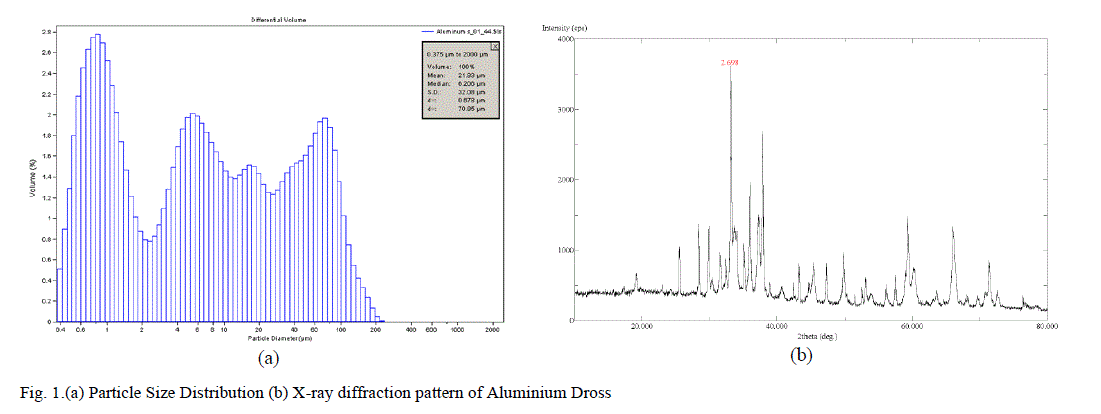 |
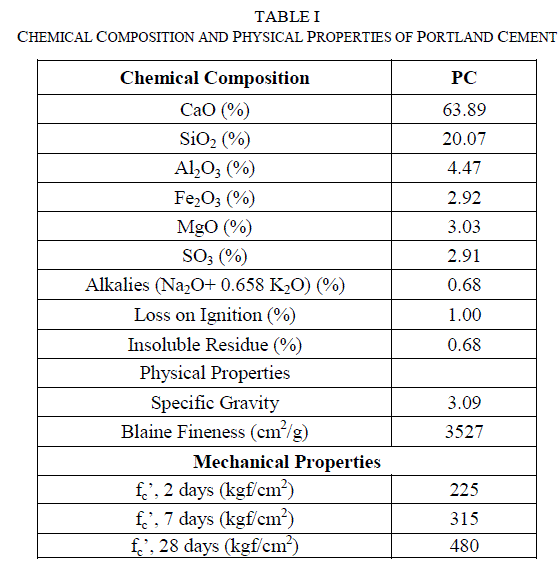 |
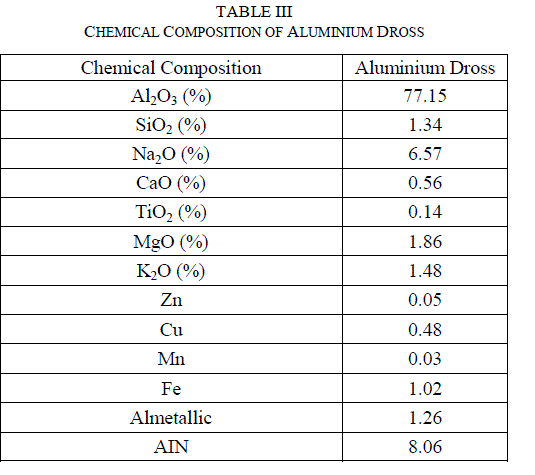 |
| 3) Aggregates: Crushed limestone and sand produced in Qatar is used as the aggregate in this study. The crushed limestone named as coarse aggregate with a nominal size of 25 mm has specific gravity of 3.095, unit weight of 1.93 kg/l and water absorption of 0.65%. The fine aggregate, sand, has the specific gravity of 2.73, unit weight of 1.65 kg/l and water absorption of 2.15%. Table III presents the grading of fine and coarse aggregates determined according to the ASTM C 136 [9]. |
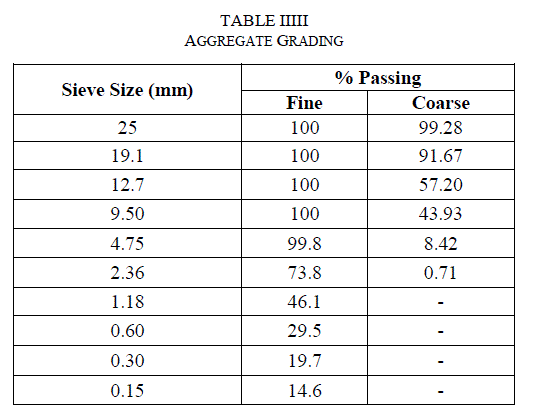 |
| B. Experimental Procedure 1) Mixture Proportions:The concrete mixture proportions of the mixes are given in Table IV. As seen from the table, within the scope of the experimental program five concrete mixtures were prepared. Thecontrol mixture includedonlythe Portland cement (PC) as a binder, and named as AS0 which means that there is no aluminum slag. The remaining mixtures had different aluminum slag contents of 5%, 10%, 15% and 30% by weight of Portland cement and named as AS5, AS10, AS15 and AS30, respectively. For all the mixtures, the total amount of cementitious material (PC+AS) content and slump value were kept constant. Since the slump value was kept constant, water was gradually added to the mixtures and therefore the water to cementitious ratio (w/cm) was not kept constant and changed from 0.45 to 0.53. |
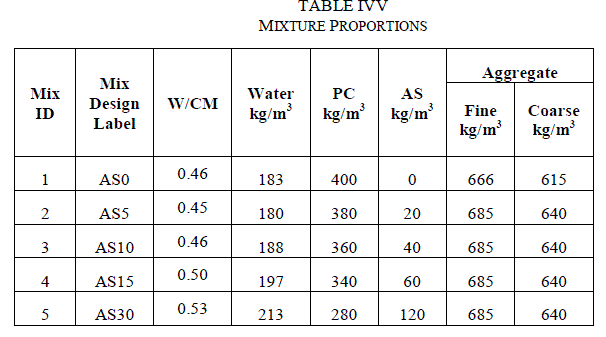 |
| 2) Specimen Preparation: Concrete mixtures were prepared using an electrically driven mechanical mixer with a 200 kg capacity. The preparation procedure was the same for all mixtures. For all concrete mixture, first of all, the fine and coarse aggregates were mixed for 1 minute and the cementitious materials (cement or cement and aluminium dross) were added and mixed for 1 more minute. Eventually, the water was gradually added. After completing the mixing procedure, the air content, slump and setting time were determined for the fresh concrete properties. From each concrete mixture, fourteen 100x200 mm cylinder specimens and two 15x15x15 cm cube specimens were cast to determine the hardened properties like compressive strength, permeability tests and corrosion test. After 24 hours, the specimens were removed from the molds and cured in water at a temperature of 20±2°C until the date of testing. |
| 3) Tests on Fresh Concrete: In this study, the air content and setting time tests of fresh concrete were determined according to the related ASTM standard test methods. The air content of freshly mixed concrete was determined by pressure method described in ASTM C 231[10]. In this study, the type B meter of which operational principle consists of equalizing a known volume of air at a known pressure in a sealed air chamber with the unknown volume of air in the concrete sample was used. The setting time of concrete mixtures was determined by measuring the times required for the concrete to reach specified values of resistance to penetration as described in ASTM C 403M-08 [11]. 4) Tests on Hardened Concrete: The hardened concrete properties were evaluated by performing compressive strength, absorption, sorptivity, compressive strength and corrosion resistance tests. 4.1)Compressive Strength: The compressive strength test was performed according to the procedure defined in ASTM C 39 using a universal testing machine [12]. A total of nine 100x200 mm concrete cylinders were tested for each mixture. The compressive strength was determined at 3 days, 7 days and 28 days by using three cylinders at each age. 4.2) Permeability Tests: The permeability properties of concrete samples were evaluated by measuring the water absortion capacity and the rate of water absorption of the concrete samples.In order to determine the water absorption capacity of concrete samples ASTM C 642 test procedure was performed and the absorption of the concrete expressed as the percentage water over the dry mass of concrete was determined [13]. In this test, two moist cured (for 28 days) Ø100x50 mm disc specimens from each mixture were dried in an oven at 105±5°C to a constant weight. After removing each specimen from the oven, the specimens were immersed in water and weighed every 24 hours to check the increase in mass, until an increase in mass was less than 0.5% of the larger value of mass. At the end of this test, the total volume of permeable pores was determined, because water absorption can only take place in pores which were emptied during drying and filled with water during the immersion period. Furthermore, sorptivity test based on the ASTM C 1585 was performed to determine the rate of absorption of water by hydraulic cement concrete by measuring the increase in the mass of a disc specimen at given intervals of time (1, 5, 10, 20, 30, 60, 180, 240, 300 and 360 min) when only one surface of the specimen is exposed to water, with the depth of water between 3 to 5 mm [11]. Two moist cured (for 28 days) Ø100x50 mm disc specimens were first dried according to the procedure described in the absorption test and one side of each specimen was sealed by using a silicone coating. After measuring the increase in the mass of discs at given times, the rate of absorption (i in mm), defined as the change in mass (g) divided by the cross sectional area of the test specimen (mm2) and the density of water (g/mm3), was plotted against square root of time (t1/2 in min1/2). The slope of the obtained line defines the sorptivity of the specimen during the initial six hours of testing. |
| 4.3) Corrosion Test: Five concrete mixtures with different aluminium dross composition were prepared and 15x15x25 cm3 concrete samples were prepared from each mixture for the corrosion test.Samples were taken from each Mix before hardening to measure its pH (and [HO-]), chloride and fluoride ions concentration using a pH meter for ion chromatography. Steel Rebar pieces of 20 mm in diameter and 30 cm in length, having the specifications shown in Table V, were embedded (one piece per mold) in a partial way within the mold so that 20 cm was put inside the concrete and 10 cm was outside. The steel rebar pieces were brought from Qatar steel. The corrosion rate measurements were carried out using GAMRY Reference 600 Potentiostat. The measurement technique was the linear polarization (LP) technique. In these experiments, the potential was shifted 10 mV below and above the open circuit potential (OCP) starting from the cathodic region and going to the anodic one passing through the OCP. It is worthy to mention here that the IR potential drop in the concrete was compensated automatically by the potentiostat using the current interruption technique. In these measurements, the steel rebar acted as the working electrode while the reference electrode was Ag/AgCl and the counter electrode was a 10 cm Pt wire of 1 mm diameter. |
 |
IV. RESULTS AND DISCUSSION |
| A. Fresh Concrete Properties In this study, for all the mixtures, the slump value was kept constant. Moreover, the air content and the setting time properties were evaluated through the fresh concrete and the results are presented in Table VI. As it can be observed from the table, when the aluminium dross is used up to 15% replacement of cementitious material, increasing aluminium slag content accelerates the hardening. However, when 30% of cement weight is replaced by aluminium dross, it can be seen that aluminium dross retards the setting time of concrete. The reason of the extension or shortening of setting time with the replacement of aluminium dross can be explained by the presence of nanoparticles during hydration process. Since the nano particles of aluminium dross have higher surface area, particles absorb a rather large amount of liquid. Thus, up to 15% replacement of cementitious material, setting time is decreased. However, higher amount of replacement causes a decrease in the hydration rate of the main clinker phases so there is an extension for the final and initial setting time as more than 2 hours. This result is similar to the study of Lee and Liu who focused on the recovery of hazardous industry sludge by using as a useful resource in concrete [12]. In their study, they also observed that increasing amount of industrial sludge shortens the setting time of concrete. On the other hand, air content of concrete increases with increasing aluminium dross content. This can be explained by the large absorption capacity of aluminium dross which is an indicative of its high porosity or entrapped air content. Since the aluminium dross incorporates air into the concrete mixture, aluminium dross acts as an expanding agent which was also observed during casting as presented in Figure 3. The expansion effect of aluminium dross is also discovered in the study of Cesar who used aluminium dross as a new ingredient for producing mortar in 2002 [13]. Expansion is also attributed to hydrolysis of Al and Al2O3 since the medium is alkaline to form the voluminous Al(OH)3. |
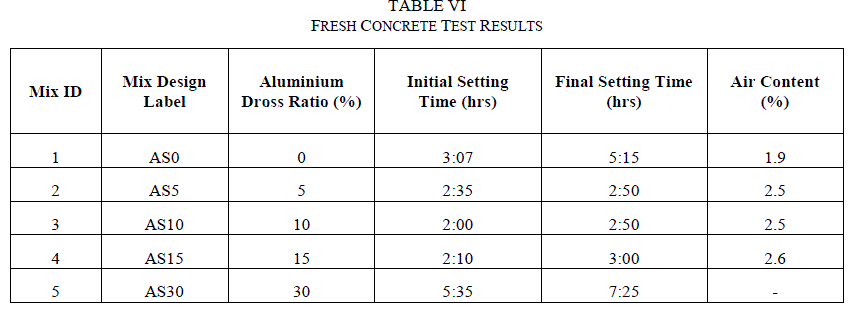 |
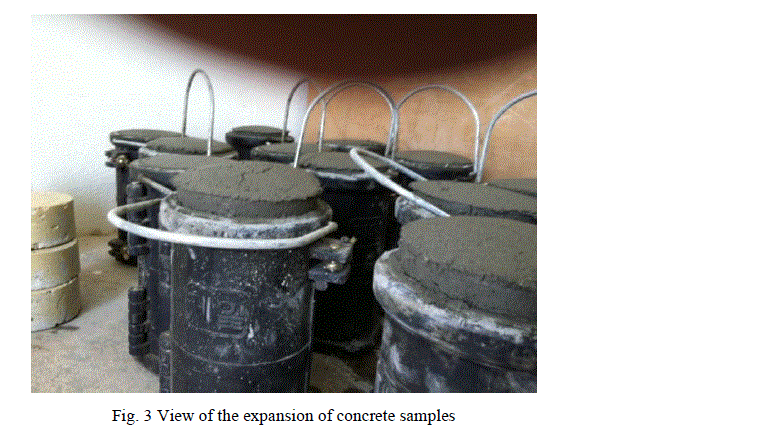 |
| B. Hardened Concrete Properties 1) Compressive Strength: The mean compressive strength of cylindrical concrete specimens at 3, 7 and 28 days of age is presented in Table VII. Also the coefficients of variations calculated from an average of three specimens at each age are included in the presented table. However, for the mixture 5 labelled as AS30 which means that 30% of cement is replaced by aluminium dross, the compressive strength test results could not be obtained since all the samples were broken during casting as seen in Figure 4. Therefore it can be concluded that high volume aluminium dross replacement is not appropriate. Figure 5 presents the effect of aluminium dross content on the compressive strength at 3, 7 and 28 days of age. As seen from the figure, the compressive strength value decreases with increasing aluminium dross content and this is related with the mixtures including high amount of aluminium dross have higher air content. In the study of Lee and Liu [12], it is concluded that curing for more than 7 days has a positive effect on strength gain. This result is consistent with those of other studies and suggest that strength characteristic of cement mortar can be increased by adding nano-particles after curing [14-16]. Thus, for further studies, curing effect on the strength gain of aluminium dross added mortar/concrete should be considered. |
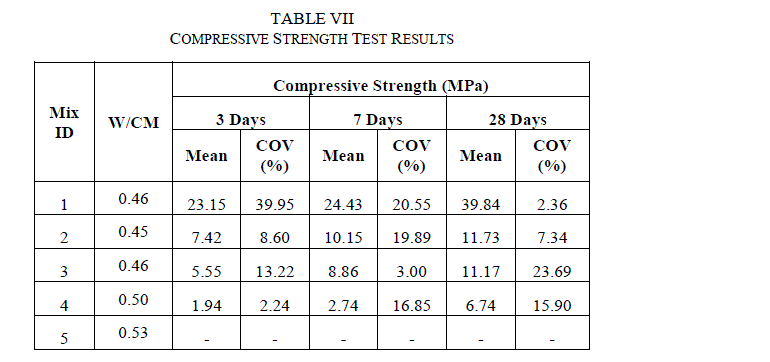 |
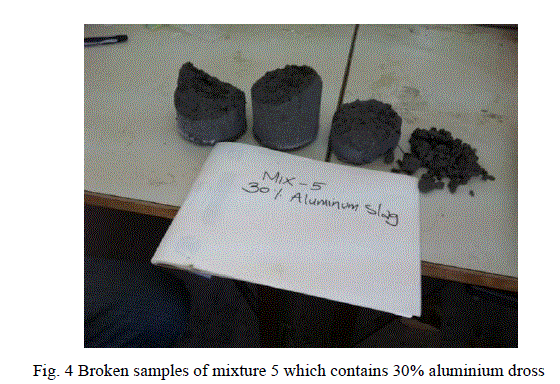 |
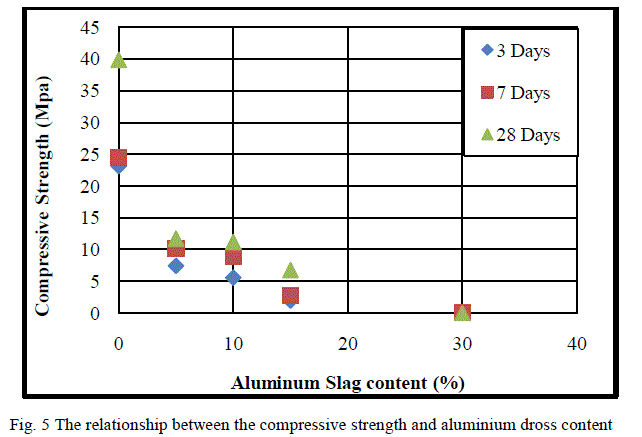 |
| 2) Permeability: In this project, the permeability properties of concrete samples were evaluated by performing water absorption and sorptivity tests and the results are given in Table VIII. The effect of aluminium dross content on the sorptivity index and water absorption capacity of concrete samples can be seen in Figure 6 (a) and (b), respectively. In these figures, it can be observed that increase in the aluminium dross content results in the increase in permeability values of concrete samples and this result is also compatible with the compressive strength results. |
 |
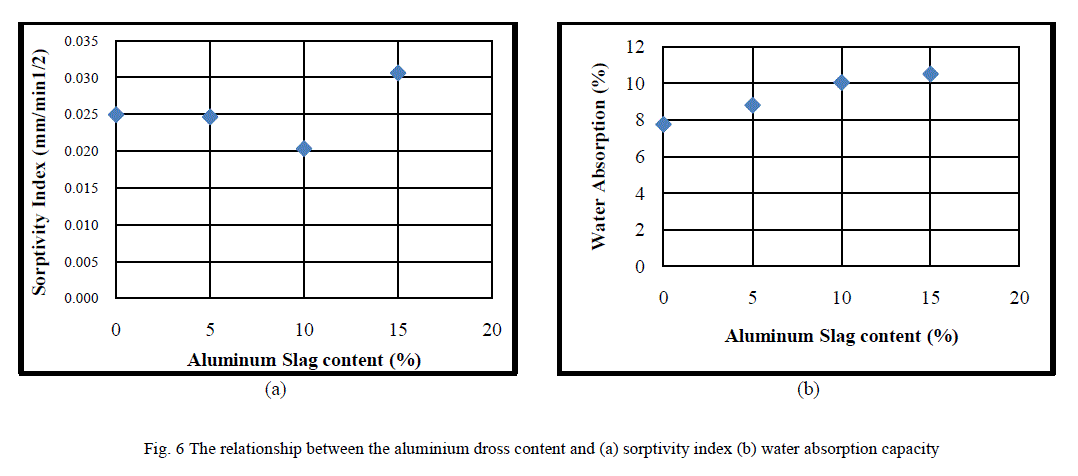 |
| 3) Corrosion:Figure 7 shows the corrosion rate of the steel rebar within the concrete as the aluminium dross volume percentage increases from 0 to 30%. It can be seen that as the slag content increases from 0% to 10%, the corrosion rate decreases. This behaviour was reversed when the slag content exceeded the 10% threshold where a significant increase in the corrosion rate started to be measured. The reason for this inflection in behaviour might be attributed to the chemical composition of the slag which affects the concrete pore solution. The presence of calcium and aluminium hydroxides and alkali metal ions e.g. Na+ and K+ maintains the pore solution pH at a value around 11 which passivates the steel rebar, i.e. the high pH value decreases the corrosion rate but the presence of Cl-and F- ions increases the localized corrosion rate. The chloride ion concentration, [Cl-] necessary to start the pitting corrosion for steel embedded in concrete is termed critical chloride content or chloride threshold value, abbreviated Ccrit. It depends on many factors but the essential parameters for Ccritare the pH of the concrete pore solution and the presence of other halide ions e.g. F- which is one the most aggressive halide ions that increases the corrosion rate of steel. Asthe concentration of hydroxide ions increases, the amount of chloride and/or fluoride ions required for pitting corrosion initiation increases. Hausmann [17], suggested a critical ratio of chloride and hydroxide ions of [Cl– ]/[OH–] = 0.6; in other words, when the pH is 12 instead of 11, the tolerable chloride ion concentration is ten times higher than at pH 11. It was noticed that increasing the slag volume percentage from 0 to 10% resulted in an increase in the concentration of the [OH-], [F-] and [Cl-]from 1x10-3, 0, and 1.3x10-4, to 1x10-2, 4.47x10-4 and 3.4x10-4mol L-1respectively.This resulted in a decrease in the corrosion rate from 0.44 to 0.2 mpympy at a slag volume of 0% and 10%, respectively. It can be noticed, also, that the ratio of the total halides’ ion concentration to the hydroxide ion concentration decreased from 1300 at 0% to 787 at 10%. Increasing the slag volume percentage higher than 10% did not result in any increase in the concrete pore solution pHbut at the same time it resulted in a significant increase in the [Cl-] and [F-] (7.9 x 10-4 M L-1 for each) which resulted in an increase in the ratio of the total halides’ ion concentration to the hydroxide ion concentration from 787 at a slag volume of 10% to 1580 at a slag volume of 30% The increase in this ratio increased the corrosion rate significantly from 0.2mpy at a slag volume of 10% to 1.2 mpyat a slag volume of 15 and 30%, respectively. It is also worthy to mention here that the increase in the corrosion at a slag volume of 30% is 6 times higher than that at 10% although the concentration of the ions is only tripled. This is assumed to be due to a local change in the pH of of the solution near the steel rebar as a result of the hydrolysis of the Fe2+ions which is produced as a result of the corrosion process. |
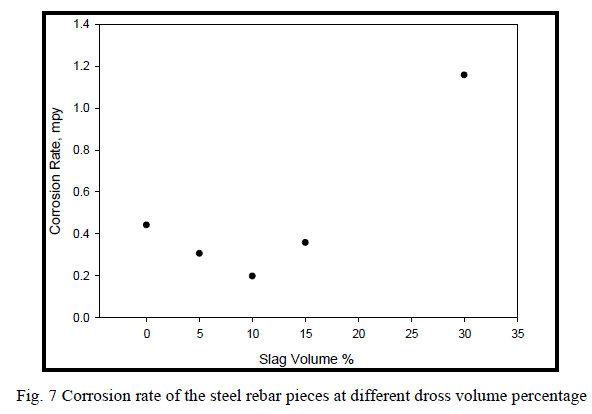 |
V. CONCLUSION |
| In this project, the objective was to investigate the mechanical and chemical behaviour of new concrete type obtained by adding aluminium dross. It was also aimed to investigate the effect of harsh environmental conditions in the Gulf region on the durability properties of aluminium dross added concrete. Within the scope of the project, many tests were performed to evaluate the properties of aluminium dross waste generated from Qatalum and the amount and the method that should be used to obtain a proper concrete was investigated. The main tasks performed during the project can be listed as the chemical and physical tests on aluminium dross, determination of the properties of fresh and hardened aluminium dross added concrete and corrosion test. The following conclusions are drawn as a result of this experimental program: |
| When aluminum slag is used in the range of certain limits (i.e. up to 15% replacement of cementitious material), increasing aluminium dross content accelerates the hardening which can be understandable since the nano particles of aluminium dross has higher surface area. |
| High volume aluminium dross replacement is not appropriate because of its high water absorption capacity. |
| Since aluminium dross acts as an expanding agent, it can be used in the manufacturing of building subfloors, blocks and pre-molded panels. |
| The compressive strength value and permeability properties of concrete decreases with increasing aluminium dross content. As the replacement percentage of aluminium dross is increased, more entrapped air occurs and this causes a negative effect on strength and permeability properties. |
| Curing effect on the strength gain of aluminium dross added mortar/concrete should be further studied. |
| Increasing the dross volume from 0 to 10% resulted in a decrease of the total halides’ ion concentration/hydroxide ion concentration ratio from 1300 to 787 which is reflected in a decrease in the corrosion rate from 0.44 to 0.2 mpy. A further increase in the dross volume to 30% resulted in an increase in the ratio to 1580 which consequently led to a significant increase in the corrosion rate to 1.2 mpy for the samples of dross volumes higher than 10%. |
ACKNOWLEDGEMENTS |
| “This report was made possible by a UREP award [UREP12-051-2-019] from the Qatar National Research Fund (a member of The Qatar Foundation). The statements made herein are solely the responsibility of the author[s].” |
References |
|